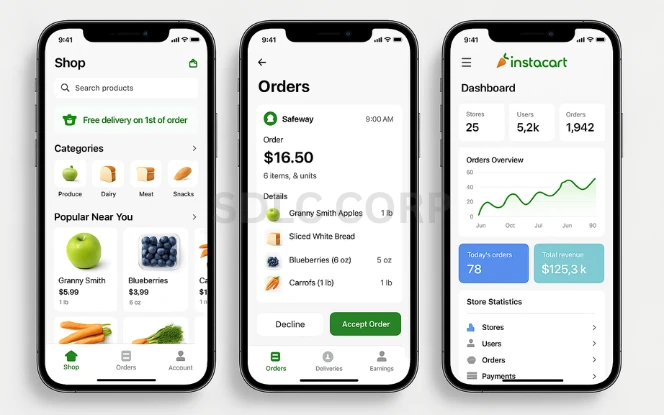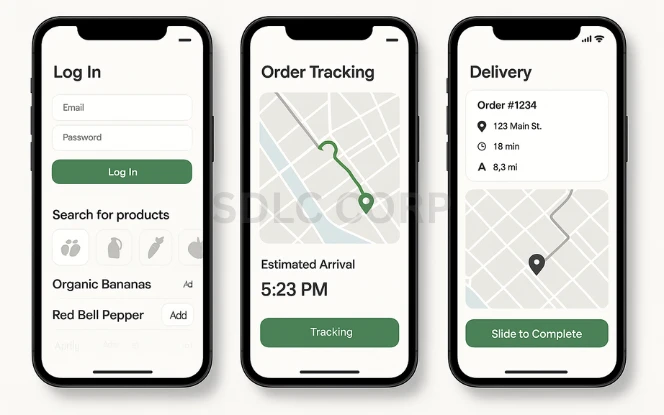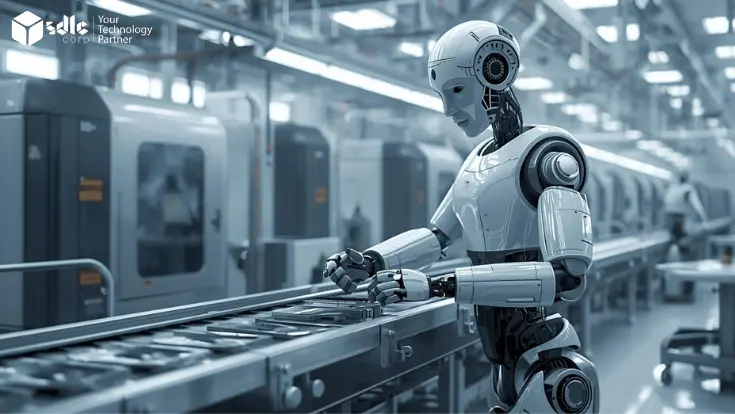In the fast-paced world of digital innovation, grocery delivery apps have become essential. As consumer demand for convenient shopping solutions grows, many entrepreneurs and businesses are exploring how to build cost to develop a delivery app like Instacart. But one question always tops the list: how much does it cost to develop a delivery app like Instacart?
To answer that, we need to explore multiple factors that influence the cost and functionality of such an app. From design and development to integrations and scalability, this comprehensive guide will walk you through everything you need to know.
Understanding the Business Model of Instacart

Before diving into costs, it’s important to understand how Instacart works. Instacart operates on a hyperlocal on-demand grocery delivery model. Users can shop from their favorite grocery stores through the app, and personal shoppers pick and deliver the items to their doorstep. The business model includes:
- Customer app for browsing and ordering groceries
- Shopper app for accepting and fulfilling orders
- Admin panel for managing stores, users, orders, and payments
This multi-faceted system is essential to replicate if you want to build a delivery app like Instacart.
Key Features That Define a Grocery Delivery App

A well-designed app should address the needs of all stakeholders involved: customers, delivery personnel, and administrators.The core features include:
For Customers:
- User registration & login
- Search and filter functionality
- Product listings with images and descriptions
- Shopping cart and checkout
- Payment gateway integration
- Real-time order tracking
- Reviews and ratings
- Push notifications
For Shoppers/Delivery Partners:
- Order request notifications
- Accept or reject delivery requests
- Navigation & route optimization
- Delivery status updates
- Earnings report
For Admins:
- Dashboard and analytics
- User and order management
- Store and inventory control
- Commission management
- Customer support
Each of these modules adds layers of complexity to the development process, which in turn affects the Instacart app development cost.
Design Complexity and UI/UX Investment

User experience is crucial for retaining customers and ensuring high engagement. A sleek, intuitive design will not only boost customer satisfaction but also enhance app performance. Investing in good UI/UX design involves:
- Wireframing and prototyping
- User flow optimization
- Branding and color schemes
This initial design phase can cost anywhere between $5,000 and $15,000, depending on the level of detail and customization.
Platform Choice: iOS, Android, or Both?

Choosing the right platform(s) is another major factor that affects the price to create an on-demand grocery delivery app. You can opt for:
- iOS only (Apple devices)
- Android only (Google devices)
- Cross-platform (React Native, Flutter, etc.)
A native app for both platforms will cost more but can provide a better user experience. Cross-platform development is more cost-effective and allows for quicker deployment, which is ideal for MVPs (Minimum Viable Products).
Backend Infrastructure and Database

A strong backend is essential for handling multiple user interactions in real time. For a feature-rich app like Instacart, the backend should support:
- Real-time updates
- Order synchronization
- Multi-store integration
- Secure payment processing
- Scalable architecture
Choosing the right backend technology (like Node.js, Ruby on Rails, or Django) and cloud services (AWS, Google Cloud, Azure) will directly influence the cost to develop delivery app like Instacart.
Payment Gateway Integration

Seamless and secure payment processing is a must. Integrating third-party payment gateways like Stripe, PayPal, or Braintree adds to development time and cost. Security compliance with PCI-DSS also requires attention. Custom payment features like wallet systems or split payments (for commission-based models) can further raise the development cost.
API Integrations

To extend app functionality, developers often rely on APIs. These can include:
- Geolocation (Google Maps API)
- SMS and Push notifications (Twilio, Firebase)
- Analytics (Google Analytics, Mixpanel)
- Inventory Management APIs
Each integration adds to both the development timeline and cost.
Development Team and Location

The cost of development varies significantly based on where your development team is located. Here is a rough breakdown:
- US/Canada: $100 – $250/hour
- Western Europe: $80 – $180/hour
- Eastern Europe: $40 – $100/hour
- India/South Asia: $20 – $60/hour
Hiring a full-stack development team (Project Manager, Frontend & Backend Developers, UI/UX Designers, QA Testers) can optimize the workflow but also increases your budget.
Maintenance and Updates

Post-launch maintenance is an ongoing cost that includes:
- Bug fixes
- Security patches
- Feature updates
- Server management
On average, you should allocate 15-20% of the initial development cost annually for maintenance.
Timeframe for Development

The time required to build an app like Instacart typically spans:
- Basic MVP: 3-5 months
- Medium Complexity App: 5-8 months
- Full-Scale Premium App: 8-12 months
Time is money in the tech world. The longer the development period, the higher the overall cost.
Cost Breakdown Overview

Here’s a rough estimate of the Instacart app development cost based on complexity:
| App Complexity | Estimated Cost Range |
|---|---|
| MVP Version | $20,000 - $40,000 |
| Medium Complexity | $40,000 - $80,000 |
| Premium Full-Feature | $80,000 - $150,000+ |
Remember, these are ballpark figures. Custom requirements, tech stacks, and business logic can alter the final amount considerably.
How to Reduce Development Costs Without Compromising Quality

- Start with an MVP: Validate your idea with a lean version first.
- Use Ready-Made Solutions: Leverage SDKs and templates where applicable.
- Outsource Smartly: Choose experienced developers in cost-effective regions.
- Prioritize Features: Focus on must-haves initially and roll out enhancements later.
Each of these strategies helps manage the price to create on-demand grocery delivery app while maintaining product quality.
Final Thoughts
The cost to develop a delivery app like Instacart isn’t fixed—it depends on your features, target audience, tech stack, and development team. For startups, launching with a cost-effective MVP is a smart first step. As user feedback and demand grow, scaling to a full-featured version becomes more feasible. Understanding what drives development costs will help you make informed decisions and budget effectively. Whether you’re disrupting the grocery delivery space or supporting local retailers, knowing the development cost is key to building a scalable, competitive app. Need expert guidance or a personalized estimate? Contact SDLC Corp to get started.
FAQ’s
1. How Much Does It Cost to Develop a Grocery Delivery App Like Instacart?
The cost depends on app complexity, platform, and team location:
- MVP: $20,000 – $40,000
- Mid-range App: $40,000 – $80,000
- Full-featured App: $80,000 – $150,000+
2. Which Platforms Should I Build for: IOS, Android, or Both?
- iOS only: Faster to market for Apple users
- Android only: Wider global reach
- Cross-platform (Flutter/React Native): Best for MVPs, faster & cost-effective development
3. What Are the Must-have Features for a Delivery App Like Instacart?
- Customer side: Login, search, cart, payments, order tracking
- Shopper/driver side: Order alerts, route optimization, delivery status
- Admin panel: Order management, store control, analytics, support
4. How Long Does It Take to Build an Instacart-like App?
- Basic MVP: 3–5 months
- Medium complexity: 5–8 months
- Full-feature app: 8–12 months
5. How Can I Reduce Development Costs Without Lowering Quality?
- Start with an MVP to validate the idea
- Use open-source tools & third-party APIs
- Outsource to skilled, affordable teams
- Prioritize features for version 1 and scale later






